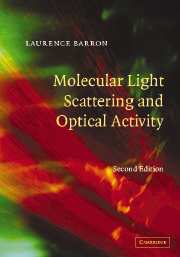Book contents
- Frontmatter
- Contents
- Preface to the first edition
- Preface to the second edition
- List of symbols
- 1 A historical review of optical activity phenomena
- 2 Molecules in electric and magnetic fields
- 3 Molecular scattering of polarized light
- 4 Symmetry and optical activity
- 5 Natural electronic optical activity
- 6 Magnetic electronic optical activity
- 7 Natural vibrational optical activity
- 8 Antisymmetric scattering and magnetic Raman optical activity
- References
- Index
4 - Symmetry and optical activity
Published online by Cambridge University Press: 07 August 2009
- Frontmatter
- Contents
- Preface to the first edition
- Preface to the second edition
- List of symbols
- 1 A historical review of optical activity phenomena
- 2 Molecules in electric and magnetic fields
- 3 Molecular scattering of polarized light
- 4 Symmetry and optical activity
- 5 Natural electronic optical activity
- 6 Magnetic electronic optical activity
- 7 Natural vibrational optical activity
- 8 Antisymmetric scattering and magnetic Raman optical activity
- References
- Index
Summary
Introduction
This chapter is a rambling affair. It collects together a number of disparate topics, all of which have some bearing on the application of symmetry arguments to molecular properties in general and optical activity in particular.
Optical activity is a splendid subject for the application of symmetry principles. As well as conventional point group symmetry, the fundamental symmetries of space inversion, time reversal and even charge conjugation have something to say about optical activity at all levels: the experiments that show up optical activity observables, the objects generating these observables and the nature of the quantum states that these objects must be able to support. There are also technical matters such as the simplification and evaluation of matrix elements using irreducible tensor methods, a topic of great importance in magnetic optical activity. One topic set apart from the others is the application of permutation symmetry to ligand sites on molecular skeletons: this generates an imposing algebra based on ‘chirality functions’ which gives mathematical insight into the phenomenon of molecular chirality.
Cartesian tensors
In this book, considerable use is made of a cartesian tensor notation, and the symmetry aspects of various phenomena discussed in terms of the transformation properties of the corresponding molecular property tensors. A review of the relevant parts of the theory of cartesian tensors is therefore appropriate. More complete accounts can be found in works such as Jeffreys (1931), Milne (1948), Temple (1960) and Bourne and Kendall (1977). A knowledge of elementary vector algebra is assumed.
- Type
- Chapter
- Information
- Molecular Light Scattering and Optical Activity , pp. 170 - 263Publisher: Cambridge University PressPrint publication year: 2004



